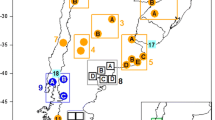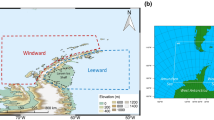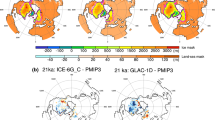Abstract
The climates of the mid-Holocene (MH), 6,000 years ago, and of the Last Glacial Maximum (LGM), 21,000 years ago, have extensively been simulated, in particular in the framework of the Palaeoclimate Modelling Intercomparion Project. These periods are well documented by paleo-records, which can be used for evaluating model results for climates different from the present one. Here, we present new simulations of the MH and the LGM climates obtained with the IPSL_CM5A model and compare them to our previous results obtained with the IPSL_CM4 model. Compared to IPSL_CM4, IPSL_CM5A includes two new features: the interactive representation of the plant phenology and marine biogeochemistry. But one of the most important differences between these models is the latitudinal resolution and vertical domain of their atmospheric component, which have been improved in IPSL_CM5A and results in a better representation of the mid-latitude jet-streams. The Asian monsoon’s representation is also substantially improved. The global average mean annual temperature simulated for the pre-industrial (PI) period is colder in IPSL_CM5A than in IPSL_CM4 but their climate sensitivity to a CO2 doubling is similar. Here we show that these differences in the simulated PI climate have an impact on the simulated MH and LGM climatic anomalies. The larger cooling response to LGM boundary conditions in IPSL_CM5A appears to be mainly due to differences between the PMIP3 and PMIP2 boundary conditions, as shown by a short wave radiative forcing/feedback analysis based on a simplified perturbation method. It is found that the sensitivity computed from the LGM climate is lower than that computed from 2 × CO2 simulations, confirming previous studies based on different models. For the MH, the Asian monsoon, stronger in the IPSL_CM5A PI simulation, is also more sensitive to the insolation changes. The African monsoon is also further amplified in IPSL_CM5A due to the impact of the interactive phenology. Finally the changes in variability for both models and for MH and LGM are presented taking the example of the El-Niño Southern Oscillation (ENSO), which is very different in the PI simulations. ENSO variability is damped in both model versions at the MH, whereas inconsistent responses are found between the two versions for the LGM. Part 2 of this paper examines whether these differences between IPSL_CM4 and IPSL_CM5A can be distinguished when comparing those results to palaeo-climatic reconstructions and investigates new approaches for model-data comparisons made possible by the inclusion of new components in IPSL_CM5A.











Similar content being viewed by others
References
Alkama R, Kageyama M, Ramstein G, Marti O, Ribstein P, Swingedouw D (2007) Impact of a realistic river routing in coupled ocean–atmosphere simulations of the Last Glacial Maximum climate. Clim Dyn 30:855–869
Aumont O, Bopp L (2006) Globalizing results from ocean in situ iron fertilization studies. Global Biogeochem Cycles 29:GB2017. doi:10.1029/2005GB002591
Bartlein PJ, Harrison SP, Brewer S, Connor S, Davis BAS, Gajewski K, Guiot J, Harrison-Prentice TI, Henderson A, Peyron O, Prentice IC, Scholze M, Seppä H, Shuman B, Sugita S, Thompson RS, Viau AE, Williams J, Wu H (2011) Pollen-based continental climate reconstructions at 6 and 21 ka: a global synthesis. Clim Dyn 37:775–802
Berger AL (1978) Long-term variations of daily insolation and quaternary climatic changes. J Atmospheric Sci 35:2362–2367
Bigelow NH, Brubaker LB, Edwards ME, Harrison SP, Prentice IC, Anderson PM, Andreev AA, Bartlein PJ, Christensen TR, Cramer W, Kaplan OJ, Lozhkin AV, Matveyeva NV, Murray DF, McGuire AD, Razzhivin VY, Ritchie JC, Smith B, Walker DA, Gajewski K, Wolf V, Holmqvist BH, Igarashi Y, Kremenetskii K, Paus A, Pisaric MFJ, Volkova VS (2003) Climate change and Arctic ecosystems: 1. Vegetation changes north of 55°N between the Last Glacial Maximum, mid-Holocene, and present. J Geophys Res 108:8170
Braconnot P, Harrison SP, Kageyama M, Bartlein PJ, Masson-Delmotte V, Abe-Ouchi A, Otto-Bliesner B, Zhao Y (2012) Evaluation of climate models using palaeoclimatic data. Nat Clim Change 2:417–424
Braconnot P, Joussaume S, Marti O, de Noblet N (1999) Synergistic feedbacks from ocean and vegetation on the African monsoon response to mid-Holocene insolation. Geophys Res Lett 26:2481–2484
Braconnot P, Luan Y, Brewer S, Zheng W (2011) Impact of Earth’s orbit and freshwater fluxes on holocene climate mean seasonal cycle and ENSO characteristics. Clim Dyn 36:1081–1092. doi:10.1007/s00382-011-1029-x
Braconnot P, Otto-Bliesner B, Harrison S, Joussaume S, Peterchmitt J-Y, Abe-Ouchi A, Crucifix M, Driesschaert E, Fichefet T, Hewitt CD, Kageyama M, Kitoh A, Laine A, Loutre M-F, Marti O, Merkel U, Ramstein G, Valdes P, Weber SL, Yu Y, Zhao Y (2007a) Results of PMIP2 coupled simulations of the mid-Holocene and Last Glacial Maximum—part 1: experiments and large-scale features. Clim Past 3(2):261–277
Braconnot P, Otto-Bliesner B, Harrison S, Joussaume S, Peterchmitt J-Y, Abe-Ouchi A, Crucifix M, Driesschaert E, Fichefet T, Hewitt CD, Kageyama M, Kitoh A, Loutre M-F, Marti O, Merkel U, Ramstein G, Valdes P, Weber L, Yu Y, Zhao Y (2007b) Results of PMIP2 coupled simulations of the mid-Holocene and Last Glacial Maximum—part 2: feedbacks with emphasis on the location of the ITCZ and mid- and high latitudes heat budget. Clim Past 3(2):279–296
Brown J, Collins M, Tudhope AW, Toniazzo T (2008) Modelling mid-Holocene tropical climate and ENSO variability: towards constraining predictions of future change with palaeo-data. Clim Dyn 30:19–36
Claussen M, Gayler V (1997) The greening of the Sahara during the mid-Holocene: results of an interactive atmosphere-biome model. Global Ecol Biogeogr Lett 6:369–377
Clement AC, Seager R, Cane MA (2000) Suppression of El Nino during the mid-Holocene by changes in the Earth’s orbit. Paleoceanography 15:731–737
Collins M, An S-I, Cai W, Ganachaud A, Guilyardi E, Jin F-F, Martozke J, Lengaigne M, Power S, Timmermann A, Vecchi G, Wittenberg A (2010) The impact of global warming on the tropical pacific and El Niño. Nat Geosci 3:391–397
Crucifix M (2006) Does the Last Glacial Maximum constrain climate sensitivity. Geophys Res Lett 33:L18701
de Noblet-Ducoudré N, Claussen M, Prentice C (2000) Mid-Holocene greening of the Sahara: first results of the GAIM 6000 year BP experiment with two asynchronously coupled atmosphere/biome models. Clim Dyn 16:643–659
Dufresne J-L, Foujols M-A, Denvil S, Caubel A, Marti O in revision, this special issue. Climate change projections using the IPSL-CM5 Earth system model with an emphasis on changes between CMIP3 and CMIP5. Clim Dyn
Fichefet T, Morales-Maqueda AM (1997) Sensitivity of a global sea ice model to the treatment of ice thermodynamics and dynamics. J Geophys Res 102:12609–12646
Fichefet T, Morales-Maqueda AM (1999) Modelling the influence of snow accumulation and snow–ice formation on the seasonal cycle of the antarctic sea–ice cover. Clim Dyn 15:251–268
Guilyardi E, Braconnot P, Jin F-F, Kim ST, Kolasinski M, Li T, Musat I (2009) Atmosphere feedbacks during ENSO in a coupled GCM with a modified atmospheric convection scheme. J Clim 22:5698–5718
Hargreaves JC, Abe-Ouchi A, Annan JD (2007) Linking glacial and future climates through an ensemble of GCM simulations. Clim Past 3:77–87
Hargreaves JC, Annan JD (2009) On the importance of paleoclimate modelling for improving predictions of future climate change. Clim Past 5:803–814
Hewitt CD, Mitchell JFB (1997) Radiative forcing and response of a GCM to ice age boundary conditions: cloud feedback and climate sensitivity. Clim Dyn 13:821–834
Hourdin F, Foujols M, Codron F, Guemas V, Dufresne J-L, Bony S, Denvil S, Guez L, Lott F, Gatthas J, Braconnot P, Marti O, Meurdesoif Y, Bopp L (2012) Impact of the LMDZ atmospheric grid configuration on the climate and sensitivity of the IPSL-CM5A coupled model. Clim Dyn. doi:10.1007/s00382-012-1411-3
Hourdin F, Musat I, Bony S, Braconnot P, Codron F, Dufresne J-L, Fairhead L, Filiberti M-A, Friedlingstein P, Grandpeix J-Y, Krinner G, LeVan P, Li Z-X, Lott F (2006) The LMDZ4 general circulation model: climate performance and sensitivity to parametrized physics with emphasis on tropical convection. Clim Dyn 27:787–813
Joussaume S, Taylor K (1995) Status of the paleoclimate modeling intercomparison project (PMIP). In: Proceedings of the first international AMIP scientific conference (Monterrey, California, USA, 15–19 May 1995). WRCP-92, pp 425–430
Kageyama M, Laîné A, Abe-Ouchi A, Braconnot P, Cortijo E, Crucifix M, de Vernal A, Guiot J, Hewitt CD, Kitoh A, Kucera M, Marti O, Ohgaito R, Otto-Bliesner B, Peltier WR, Vettoretti G, Weber SL, MARGO project members (2006) Last Glacial Maximum temperatures over the North Atlantic, Europe and western Siberia: a comparison between PMIP models, MARGO sea-surface temperatures and pollen-based reconstructions. Quat Sci Rev 25:2082–2102
Kageyama M, Mignot J, Swingedouw D, Marzin C, Alkama R, Marti O (2009) Glacial climate sensitivity to different states of the Atlantic meridional overturning circulation: results from the IPSL model. Clim Past 5:551–570
Kohfeld KE, Harrison SP (2000) How well can we simulate past climates? Evaluating the models using global environmental data sets. Quat Sci Rev 19:321–346
Krinner G, Viovy N, de Noblet-Ducoudré N, Ogée J, Polcher J, Friedlingstein P, Ciais P, Sitch S, Prentice I C (2005) A dynamic global vegetation model for studies of the coupled atmosphere-biosphere system. Global Biogeochem Cycles 19:GB1015. doi:10.1029/2003GB002199
Laîné A, Kageyama M, Braconnot P, Alkama R (2009a) Impact of greenhouse gas concentration changes on surface energetics in IPSL-CM4: regional warming patterns, land–sea warming ratios, and glacial–interglacial differences. J Clim 22:4621–4635
Laîné A, Kageyama M, Salas-Mélia D, Voldoire A, Rivière G, Ramstein G, Planton S, Tyteca S, Peterschmitt J-Y (2009b) Northern hemisphere storm tracks during the Last Glacial Maximum in the PMIP2 ocean-atmosphere coupled models: energetic study, seasonal cycle, precipitation. Clim Dyn 32:593–614
Lengaigne M, Madec G, Bopp L, Menkes C, Aumont O, Cadule P (2009) Bio-physical feedbacks in the Arctic Ocean using an Earth system model. Geophys Res Lett 36:L21602
Loveland T, Reed B, Brown J, Ohlen D, Zhu Z, Yang L, Merchant J (2000) Development of a global land cover characteristics database and IGBP DISCover from 1 km AVHRR data. Int J Remote Sens 21:1303–1330
Madec G, Delecluse P, Imbard M, Lévy C (1997) OPA version 8.1 Ocean general circulation model reference manual, 3. Tech. rep., LODYC, 91 pp
MARGO project members: (2009) Constraints on the magnitude and patterns of ocean cooling at the Last Glacial Maximum. Nat Geosci 2:127–132
Marti O, Braconnot P, Dufresne J-L, Bellier J, Benshila R, Bony S, Brockmann P, Cadule P, Caubel A, Codron F, de Noblet N, Denvil S, Fairhead L, Fichefet T, Foujols M-A, Friedlingstein P, Goosse H, Grandpeix J-Y, Guilyardi E, Hourdin F, Idelkadi A, Kageyama M, Krinner G, Lévy C, Madec G, Mignot J, Musat I, Swingedouw D, Talandier C (2010) Key features of the IPSL ocean atmosphere model and its sensitivity to atmospheric resolution. Clim Dyn 34:1–26
Masson-Delmotte V, Braconnot P, Hoffmann G, Jouzel J, Kageyama M, Landais A, Lejeune Q, Risi C, Sime L, Sjolte J, Swingedouw D, Vinther B (2011) Sensitivity of interglacial greenland temperature and δ18O: ice core data, orbital and increased co2 climate simulations. Clim Past 7:1041–1059
Masson-Delmotte V, Kageyama M, Braconnot P, Charbit S, Krinner G, Ritz C, Guilyardi E, Jouzel J, Abe-Ouchi A, Crucifix M, Gladstone RM, Hewitt CD, Kitoh A, LeGrande AN, Marti O, Merkel U, Motoi T, Ohgaito R, Otto-Bliesner B, Peltier WR, Ross I, Valdes PJ, Vettoretti G, Weber SL, Wolk F, Yu Y (2006) Past and future polar amplification of climate change: climate model intercomparisons and ice-core constraints. Clim Dyn 26:513–529. doi:10.1007/s00382-005-0081-9
Moy C, Seltzer GO, Rodbell DT, Anderson DM (2002) Variability of El Nino/Southern Oscillation activity at millennial timescales during the Holocene Epoch. Nature 420:162–165
Ngo-Duc T, Laval K, Polcher J, Lombard A, Cazenave A (2005) Effects of land water storage on global mean sea level over the past half century. Geophys Res Lett 32:L09704
Ngo-Duc T, Laval K, Ramillien G, Polcher J, Cazenave A (2007) Validation of the land water storage simulated by organising carbon and hydrology in dynamic ecosystems (ORCHIDEE) with gravity recovery and climate experiment (GRACE) data. Water Resour Res 43:W04427
Otto J, Raddatz T, Claussen M (2009) Climate variability-induced uncertainty in mid-Holocene atmosphere-ocean-vegetation feedbacks. Geophys Res Lett. doi:10.1029/2009GL041457
Otto-Bliesner BL, Joussaume S, Braconnot P, Harrison SP, Abe-Ouchi A (2009a) Modeling and data syntheses of past climates. Eos 90:93
Otto-Bliesner BL, Schneider R, Brady EC, Kucera M, Abe-Ouchi A, Bard E, Braconnot P, Crucifix M, Hewitt CD, Kageyama M, Marti O, Paul A, Rosell-Mele A, Waelbroeck C, Weber SL, Weinelt M, Yu Y (2009b) A comparison of PMIP2 model simulations and the MARGO proxy reconstruction for tropical sea surface temperatures at Last Glacial Maximum. Clim Dyn 32(6):799–815
Pausata FSR, Li C, Wettstein JJ, Kageyama M, Nisancioglu KH (2011) The key role of topography in altering North Atlantic atmospheric circulation during the last glacial period. Clim Past 7:1089–1101
Peltier WR (2004) Global glacial isostasy and the surface of the ice-age Earth: The ICE-5G (VM2) model and GRACE. Ann Rev Earth Planet Sci 32:111–149. doi:10.1146/annurev.earth.32.082503.144359
Prentice IC, Webb T III (1998) BIOME 6000: reconstructing global mid-Holocene vegetation patterns from palaeoecological records. J Biogeogr 25:997–1005
Rivière G, Laîné A, Lapeyre G, Salas-Mélia D, Kageyama M (2010) Links between Rossby wave breaking and the North Atlantic Oscillation–Arctic Oscillation in present-day and Last Glacial Maximum climate simulations. J Clim 25:2987–3008
Schmittner A, Urban NM, Shakun JD, Mahowald NM, Clark PU, Bartlein PJ, Mix AC, Rosell-Melé A (2011) Climate sensitivity estimated from temperature reconstructions of the Last Glacial Maximum. Science 334:1385
Schneider von Deimling T, Held H, Ganopolski A, Rahmstorf S (2006) Climate sensitivity estimated from ensemble simulations of glacial climate. Clim Dyn 27:149–163
Séférian R, Bopp L, Gehlen M, Orr J, Ethé C, Cadule P, Aumont O, Salas-y Mélia D, Voldoire A, Madec G (2012) Skill assessment of three earth system models with common marine biogeochemistry. Clim Dyn. doi:10.1007/s00382-012-1362-8
Solomon S, Qin D, Manning M, Chen Z, Marquis M, Aveeryt KB, Tignor M, Miller HL (2007) Intergovernmental panel on climate change: climate change 2007: the physical science basis. Contribution of working group I to the fourth assessment report of the intergovernmental panel on climate change. Cambridge University Press, Cambridge
Taylor KE, Crucifix M, Braconnot P, Hewitt CD, Doutriaux C, Broccoli AJ, Mitchell JFB, Webb MJ (2007) Estimating shortwave radiative forcing and response in climate models. J Clim 20:2530–2543
Taylor KE, Stouffer RJ, Meehl GA (2012) An overview of CMIP5 and the experiment design. Bull Am Meteorol Soc. doi:10.1175/BAMS-D-11-00094.1
Texier D, De Noblet N, Harrison SP, Haxeltine A, Jolly D, Joussaume S, Laarif F, Prentice IC, Tarasov P (1997) Quantifying the role of biosphere-atmosphere feedbacks in climate change: coupled model simulations for 6000 years BP and comparison with paleodata for northern Eurasia and northern Africa. Clim Dyn 13:865–882
Tudhope AW, Chilcott CP, McCulloch MT, Cook ER, Chappell J, Ellam RM, Lea DW, Lough JM, Shimmield GB (2001) Variability in the El Nino—Southern Oscillation through a Glacial-Interglacial Cycle. Science 291:1511–1517
Valcke S (2006) OASIS3 user guide (prism_2-5),PRISM report no 2. Tech. Rep. TR/CMGC/06/73, CERFACS, Toulouse, France, 60
Wohlfahrt J, Harrison SP, Braconnot P (2004) Synergistic feedbacks between ocean and vegetation on mid- and high-latitude climates during the mid-Holocene. Clim Dyn 22:223–238. doi:10.1007/s00382-003-0379-4
Wohlfahrt J, Harrison SP, Braconnot P, Hewitt CD, Kitoh A, Mikolajewicz U, Otto-Bliesner BL, Weber SL (2008) Evaluation of coupled oceanatmosphere simulations of the mid-Holocene using palaeovegetation data from the northern hemisphere extratropics. Clim Dyn 31:871–890
Woillez M-N, Kageyama M, Krinner G, de Noblet-Ducoudré N, Viovy N, Mancip M (2011) Impact of CO2 and climate on the Last Glacial Maximum vegetation: results from the ORCHIDEE/IPSL models. Clim Past 7:557–577
Yoshimori M, Yokohata T, Abe-Ouchi A (2009) A comparison of climate feedback strength between CO2 doubling and LGM experiments. J Clim 22:3374–3395
Zhang Q, Sundqvist HS, Moberg A, Körnich H, Nilsson J, Holmgren K (2010) Climate change between the mid and late holocene in northern high latitudes—part 2: model-data comparisons. Clim Past 6:609–626
Zheng W, Braconnot P, Guilyardi E, Merkel U, Yu Y (2008) ENSO at 6ka and 21ka from ocean-atmosphere coupled model simulations. Clim Dyn 30:745–762
Acknowledgements
The work presented in this paper has largely benefited from the work of our colleagues of the IPSL Climate Modelling Centre. The research leading to these results was supported by CNRS, the INSU-LEFE French Program under the MissTerre project, the French programs ANR05-BLAN0275-01 “FORCLIM” and ANR-10- PDOC-005-01 “Ecogely”. It also received support from the COMBINE EU project (EC IP, Grant Agreement number 226520). This work also benefited from the HPC resources of CCRT and IDRIS made available by GENCI (Grand Equipement National de Calcul Intensif), CEA (Commissariat à l’Energie Atomique et aux Energies Alternatives) and CNRS (Centre National de la Recherche Scientifique). We also would like to thank the anonymous referees for their constructive and helpful remarks on this long manuscript.
Author information
Authors and Affiliations
Corresponding author
Additional information
This paper is contribution to the special issue on the IPSL and CNRM global climate and Earth System Models, both developed in France and contributing to the 5th Coupled Model Intercomparison Project.
Rights and permissions
About this article
Cite this article
Kageyama, M., Braconnot, P., Bopp, L. et al. Mid-Holocene and Last Glacial Maximum climate simulations with the IPSL model—part I: comparing IPSL_CM5A to IPSL_CM4. Clim Dyn 40, 2447–2468 (2013). https://doi.org/10.1007/s00382-012-1488-8
Received:
Accepted:
Published:
Issue Date:
DOI: https://doi.org/10.1007/s00382-012-1488-8




